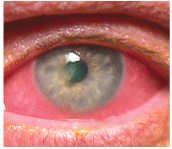 Q: A patient presented after something flew into his eye while using a gas-powered weed trimmer. A moderate-sized abrasion was present with some infiltrates. Should I be worried about a fungal ulcer?
Q: A patient presented after something flew into his eye while using a gas-powered weed trimmer. A moderate-sized abrasion was present with some infiltrates. Should I be worried about a fungal ulcer?
A: If a patient presents with an abrasion from vegetative matter, fungal keratitis should definitely be something to watch out for, says optometrist Tara Fowler, who just completed a residency in ocular disease at Omni Eye Services of Atlanta.
More than likely, though, a fungal infection wont be present. The chance of seeing fungal keratitis within days after the trauma is very rare, Dr. Fowler says. However, the presence of infiltrates raises some suspicion that an infection might be developing.
Treat this patient with a good antibioticpreferably a fourth-generation fluoroquinolonefor prophylactic coverage until the abrasion and infiltrates resolve, she says. (Specifically, Vigamox [moxifloxacin, Alcon] and Zymar [gatifloxacin, Allergan] may offer some slight antifungal activity.1)
This abrasion from a weed trimmer quickly progressed to a fungal ulcer.
Also, follow the patient closely during the healing period. Because fungi are insidious and persistent organisms, they can remain viable within biological media, including the cornea, for months. So, if a fungal infection does occur, it is often weeks to months after the initial insult, Dr. Fowler says.

What are the warning signs of a fungal infection? If the cornea begins to take on the appearance of an infectious ulcer after trauma with vegetative matter, be suspicious for fungal infection, Dr. Fowler says. Consider treating it prophylactically with amphotericin B 0.15% or natamycin 5%. Voriconazole is emerging as an effective treatment also, she adds.2
The classic fungal ulcer has a soft, grayish-white infiltrate of cells with indistinct feathery borders and is often accompanied by satellite stromal lesions. An associated ring infiltrate, anterior chamber reaction, or hypopyon may also be present.
However, the fact of the matter is that fungal ulcers can be clinically impossible to distinguish from bacterial ulcers, she says. A good rule of thumb: Whenever a suspected bacterial keratitis is larger in size (3mm to 4mm), more centrally located, or not responding to high-dose antibiotic treatment, its a good idea to culture and add fortified antibiotics or an antifungal agent until lab results can further direct your treatment.
Q: This patient owns a landscaping company. He says that 99% of people who use weed trimmers dont use goggles. What is our role in educating patients about eye protection when doing landscaping work?
Every day, about 1,000 eye injuries occur in American workplaces, Dr. Fowler says, citing information from the U.S. Bureau of Labor Statistics (BLS). Of those workers injured, nearly three out of five are not wearing eye protection at the time of the accident.
According to the BLS, almost 70% of workplace eye injuries result from flying or falling objects or sparks striking the eyejust the kind of injury that comes from a weed trimmer. Most of those objects are smaller than a pinhead.
Landscape workers, in particular, suffer more than 1,000 eye injuries every year, the BLS reports.
As primary-care optometrists, its our job to educate these patients to wear proper eyewear, Dr. Fowler says. Safety goggles with direct venting to prevent fogging would be an ideal choice but, at the minimum, safety glasses with side protection and an anti-fog treatment should be recommended.
1. Ozdek SC, Miller D, Flynn PM, Flynn HW. In vitro antifungal activity of the fourth generation fluoroquinolones against Candida isolates from human ocular infections. Ocul Immunol Inflamm 2006 Dec;14(6):347-51.
2. Hariprasad SM, Mieler WF, Lin TK, et al. Voriconazole in the treatment of fungal eye infections: a review of current literature. Br J Ophthalmol 2008 Jul;92(7):871-8. Review.

